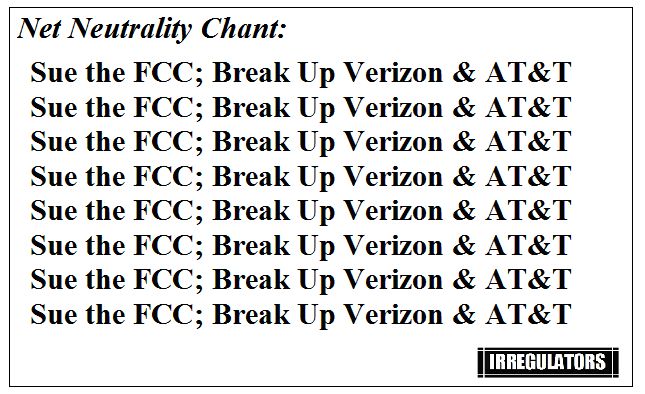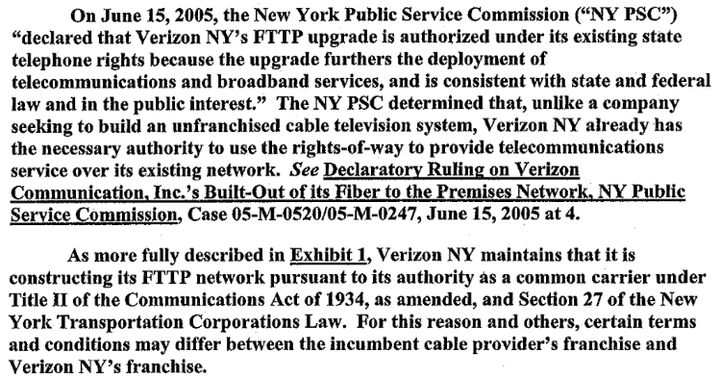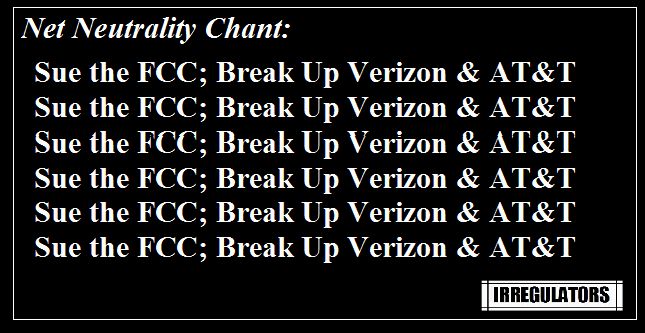
On December 14th, 2017, the FCC will vote to shut down Net Neutrality. The decision has already been made; the vote will just be a formality. The Republican ‘FCC Gang of 3’ (Pai/O'Rielly/Carr), which AT&T, Verizon et al. maneuvered into place, is now a voting block that aims to remove nearly all federal regulation and obligations on the telecommunications (phone, broadband, Internet, cable, wireless, etc.) companies and services, as well as preempting state laws.
Unfortunately, the FCC’s decision on Net Neutrality is only one of 15-20 different current FCC proceedings that are designed to all work together, which we dubbed the “Wheel of Mis-Fortune”. While Net Neutrality is a catchy phrase, it is more of a distraction; the real problems are much deeper and they have gotten far too little attention.
Sue the FCC; Break Up Verizon & AT&T
(Note: I will address the cable companies' role in all of this in a future story.)
Our position is simple. We need to have a collective ‘Ah-Ha’ moment here and restore properly functioning competitive markets, bring America the fiber networks we paid for and take back our rights.
- We Need to Stop AT&T and Verizon Wireline Utility Networks from Cross-Subsidizing their Other Subsidiaries.
Most people do not realize that there is a state telecommunications utility, like Verizon NY or AT&T-California, that are both copper and fiber optic wires and are Title II, covering most of each state. Then, there are all of the company’s other companies/subsidiaries that have been using the wireline local phone networks as a cash machine for these other, separate companies.
The companies have been able to maneuver the accounting to have the wireline customers fund the subsidiaries like the ISP company, such as Verizon Online, the wireless company, including AT&T Mobility, their cable TV business, their ‘Business Data Services’ business, and most of the other lines of business.
- We Need to Separate the Wireless Companies from the Wireline Utility Companies.
An example: Fran Shammo, Verizon’s former Executive Vice President and Chief Financial Officer stated at the Goldman Sachs Communacopia Conference on Sept. 20, 2012, that the wireline construction budgets have been charged for the construction of the wireless network.
“The fact of the matter is Wireline capital — and I won't get the number but it's pretty substantial — is being spent on the Wireline side of the house to support the Wireless growth. So the IP backbone, the data transmission, fiber to the cell, that is all on the Wireline books but it's all being built for the Wireless Company.”
- We Need to Separate the ISP Service from the Wireline Utility Network.
The Internet Service Provider, ISP, is not the phone or cable company. The ISP is a separate subsidiary that provides a connection to the Internet/World Wide Web and it used to be offered by separate companies.
In 2001, there were 9,335 ISPs in America handling the majority of the Internet traffic. The previous Republican FCC administrations helped to kill off these small, entrepreneurial companies and helped the phone and cable companies take over their customers. By 2007, about 7,000 wireline ISP companies had been put out of business, not by competition but by the government with the help of what are now AT&T and Verizon. (In more rural areas, there has been a growth of wireless ISPs, WISPs, to bring broadband to customers where the incumbent utility failed to show up.)
Thus, this is not simply about the flows of money but about the companies that have been able to vertically integrate their controls, combining the wires they control with the services that use the wires – and they have the FCC to do the dirty work.
And so – if the companies that control the wires or airwaves have their ISP service separated and customers have choices, then if a provider harms the customer, they can leave and go somewhere else.
- The FCC Must Investigate: Customers Paid Billions Per State for Upgrades Via State-Price Caps and Other ‘Investment’ Incentives.
The FCC, in every proceeding, including Net Neutrality, never makes it known that the wires of the original state public utilities are important. In fact, the FCC has failed to discuss the fact that there were broadband plans in every state since the 1990’s.
- “The Book of Broken Promises: $400 Billion Broadband Scandal & Free the Net” documents, in detail, the plans of the utilities to be upgraded (as well as Net Neutrality since its inception).
- By 2000, now-AT&T California was supposed to have 5.5 million homes and spend $16 billion on the build out.
- By 2000, Verizon Massachusetts was to have 330,000 households completed.
In each case, the state commissions agreed to give the companies billions per state to do the work—in the form of rate increases and tax perks.
- The FCC Must Investigate: Title II did Not Harm Investment. Period.
While the FCC quotes bogus pundit analyses that do not bother with actual facts from the companies and the state commissions, every comment made that Title II harms investments neglects the fact that Verizon, in every state, got the regulators to allow the company to declare the fiber ‘Title II’; this allowed the expenses to be dumped into the ‘local utility’ – cross-subsidizing almost all of the build of FiOS via local phone rates, on top of paying for the wires to the cell sites.
We wrote a summary and filed a Petition with the FCC explaining how Title II is the investment machine on the state level and how the FCC has ignored basic facts about Title II.
In fact, in the 2004-2006 timeframe, Verizon went state-to-state and got the states to allow the company to claim that the fiber optic wires being put in for FiOS were part of the state utility and that the construction budgets and staff of the state utilities would be building out the networks.
In New York, it allowed the companies to charge local phone customers multiple rate increases for these build outs. This is an excerpt from a Verizon NY cable franchise filing proving that Title II was the investment mechanism used for FTTP – Fiber to the Premises – and it represents billions of dollars that customers paid via rate increases.

What this says is – in 2005, the NY PSC claimed that the fiber to the home, “FTTP”, was Title II, Common Carrier and was part of the existing networks. I.e., FiOS expenses for the fiber would be paid for via the state utility construction budgets.
There are thousands of state documents and franchises that all have similar language and they directly contradict every statement by every co-opted consumer group, astroturf and telco-shill, paid-off pundit, corporate-funded ‘think tank’ or campaign-financed politician, not to mention the group, ALEC—that claim that Title II harms investment. “Title II” has been the way to overcharge low income families, seniors, rural areas, small businesses, cities and schools for fiber optic upgrades most will never get, or for the illegal cross-subsidies of the wires to the cell sites.
Note: Keeping Title II and fixing the mess is the issue. The telcos played the state commissions against the federal regulators, telling them different ‘facts’; this practice has been dubbed “Title Shopping” i.e.; get the best deal and hope no one notices that they gamed the regulatory system.
- GET THE MONEY: We Need to Upgrade the State Utility with Fiber and Use the Cross-Subsidies to do the Upgrades.
The legacy copper wireline networks were never properly upgraded to fiber optics over the last two decades. Instead, the FCC plans to shut off the existing legacy copper wires and replace them with inferior wireless service with data speeds of only 10 Mbps down and 1 Mbps up — which is far slower than the current definition of broadband: 25 Mbps down and 3 Mbps up.
But here is the catch: the FCC is only shutting off certain wires and hiding the fact that the majority of the wires, paid for via the state public utility customer rate increases, will be dedicated to wireless, which will not have to consider public interests and benefits.
- TAKE THE FCC TO COURT: The FCC hasn’t Audited its Own Cost Accounting Rules for 17 Years—and Is Now Attempting to Erase them as a Cover Up.
At the core of the telco cross-subsidy scheme is this: The FCC’s cost accounting rules set how costs are allocated—i.e. how much of the expenses are paid by which lines of business.
The FCC set the rules to reflect the year 2000 in 2001 and has never audited it own rules since then, but they have become a shell game, making the local networks pay 60% of almost all expenses, including Corporate Operations expenses, such as the lawyers, lobbyists and even the executive pay, while these other lines of business pay a fraction or nothing for most expenses, including construction.
In 2017, the FCC voted, (even though we filed and objected), to extend the ‘freeze’ to keep the accounting rules to be based on the year 2000, and will revisit them in 2018.
And if you hear about Chairman Pai weed-whacking the regulations, look no further. He is erasing all of the financials, known as the “Uniform System of Accounting” rules, the “USOA” – to cover up the cross-subsidies.
Conclusion: The State Utility Wires have become a Cash Machine for the Other Lines of Business – And ‘Net Neutrality’ Issues Are One of the Results.
If the companies can control the wires and the services over the wire, but are doing it based on a massive financial shell game—then we go after the money and the government agencies that are failing us.
The IRREGULATORS and New Networks Institute documented these cross-subsidies in New York. Verizon NY is in the midst of a major settlement to stop the ongoing investigation of the poor condition of their copper networks and the massive cross-subsidies with the wireless company and the other subsidiaries—based, in part, on our research and findings. But this is only a small part of fixing this mess.
Net Neutrality is important but is only a part of this picture of the corporate takeover of the FCC and our public policies. It is time to take on the FCC and to get cities and customers upgraded to fiber, open these networks to direct competition, and use the monies that have been allowed to cross-subsidize the companies’ other lines of business – for the public, that paid over and over for a fiber optic future we never got.
Breaking up AT&T and Verizon solves Net Neutrality and privacy concerns, supplies funding for network upgrades, and brings back competition and lower rates.
Going forward with the FCC’s plan condemns a large part of America to a smart phone with 10Mbps down 1Mbps up – and allows the phone and cable companies to track you and even sell information about you, and charge you extra because there is no competition—They are the Phone Company.
We broke up AT&T for its controls over America’s communications. Now we have a tight gang of companies that have taken over… again.
Repeat after me: It is time to:

